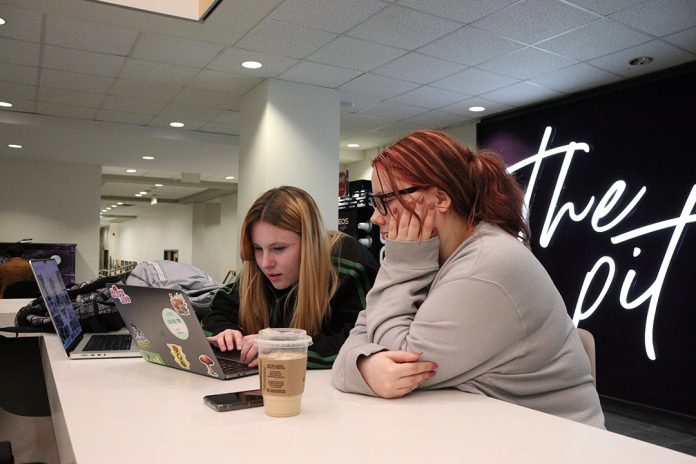Waking up, opening your school-issued Chromebook, completing assignments alone and then closing it at the end of the day — this was the routine for many Canadian high school students at the height of COVID-19.
Addie Parish, a Durham College (DC) carpentry and renovation student, said, “Because of social distancing and other restrictions, the best aspects of high school that I looked forward to were taken away.”
Parish’s experience reflects a broader reality—many students felt a sense of loss during the pandemic. Yet, the disruptions also accelerated shifts in education, forcing both teachers and students to adapt in ways that continue to shape learning today.
Five years later, education continues to evolve as the innovations introduced in 2020 become lasting practices.
Before COVID-19, many classrooms relied on lectures and static lesson plans. Now, education is more technology-driven, interactive and student-focused.
Bill Hunter, a professor at Ontario Tech University and an educational expert, noted how the rapid transition to online learning revealed the adaptability of students and teachers.
“Many people were surprised by what they could do and are pleased with the outcomes. They’re now integrating online tools more frequently, even in face-to-face classes,” said Hunter.
During the pandemic, students had to be more self-reliant in managing their learning. They adapted to digital platforms, completed assignments independently and engaged with their studies in new ways.
After months of online learning, classrooms shifted toward active engagement. Educators adopted student-centred approaches, prioritizing group discussions and collaborative activities.
Parish finds that online platforms provide valuable support for her program. “I love how you can view a summary of all your classes to see what is due and when,” said Parish.
With the growing availability of hybrid and online learning options, Statistics Canada reported that from the 2018/2019 academic year to the 2022/2023 academic year, nearly 100,000 more students were enrolled.
The pace of technological change demands that workers develop strong critical-thinking and collaboration skills. New teaching methods are preparing students to meet these demands.
This rise in enrolment reflects a shifting educational landscape, where students are seeking flexible learning options that align with the evolving demands of the workforce. As technology continues to reshape industries, education must equip students with the critical-thinking and collaboration skills necessary to thrive.
Technology has played a key role in this transformation. Schools have adopted online platforms and many have remained essential even as in-person learning has returned.
Digital textbooks and grading platforms like Google Classroom and Desire2Learn (D2L) are now central to education. These tools allow teachers to track progress and provide real-time feedback.
Hybrid learning models, which blend in-person and online learning, have become popular, allowing students to control the pace of their learning while benefiting from the structure of the classroom.
Parish said the hybrid format used in trades programs is necessary to succeed.
“In-person and hands-on learning is essential for me,” she said. “Online platforms are also very helpful because I have all of my professors contacts in one space in case I need to reach out for help with something.”
Recorded lectures and interactive materials let students tailor their education to fit their needs. The success of hybrid learning has led many students to pursue their education fully online or in a hybrid format.
“Even though many initially doubted that online teaching could work effectively, the results have shown otherwise,” said Hunter. “The pandemic opened up new possibilities for how education can be delivered, and these possibilities are here to stay.”
Classroom technology has revolutionized the teaching experience. Digital projectors and interactive whiteboards make it easier for instructors to incorporate many platforms to engage students.
These tools create a dynamic learning environment, allowing educators to shift between teaching strategies like collaborative group work, video lessons and virtual discussions.
Initially, the pandemic required schools to rethink classroom layouts to comply with social distancing measures. Many schools now feature flexible seating arrangements, such as movable desks and circular seating.
While the pandemic accelerated these changes, the impact on education goes beyond temporary fixes.
Interactive, technology-enhanced learning and more flexible classroom designs signal a long-term transformation. These changes represent a shift in how education is delivered and experienced.
According to the Canada Digital Learning Research Association (CDLRA), only five per cent of post-secondary institutions do not provide online courses, meaning 95 per cent of Canada’s education can be pursued online.
In this era, students are not only academically prepared but also equipped with the skills needed to thrive in a rapidly changing world. The future of education is poised to become more engaging, adaptive and suited to the demands of the 21st century.
One of the biggest challenges of switching to asynchronous learning during COVID-19 was access, particularly in rural areas, where reliable internet remains an issue. Asynchronous learning, a form of education where students engage with course material, assignments and activities at their own pace without real-time interaction with instructors or classmates, depends heavily on stable internet access.
In the book Thriving Online: A Guide for Busy Educators, Hunter and Robin Kay predicted the future of online learning in their chapter “What’s Next?”
“Our second prediction is that internet connection will increasingly be considered a necessity and access will grow globally,” they wrote. “We hope that with a better understanding of the barriers and the international community’s support, developing countries will not be left behind.”
Hybrid and online learning have rapidly expanded and educators like Bill Hunter and Robin Kay are actively shaping their integration into mainstream education worldwide.
The transformation in education sparked by the pandemic continues to shape how students engage with learning, blending technology with hands-on experiences. As experts like Bill Hunter and Robin Kay guide the way, the future of education promises a more flexible, inclusive, and adaptive system that prepares students for a rapidly changing world.




